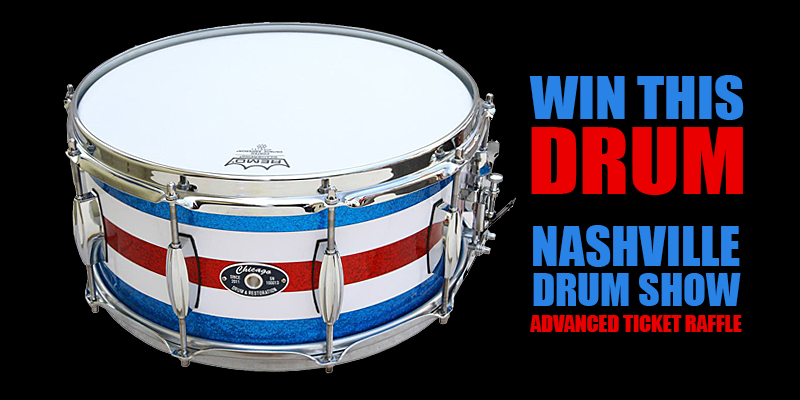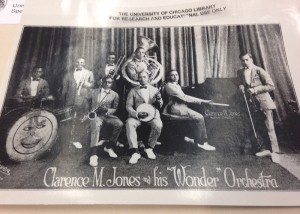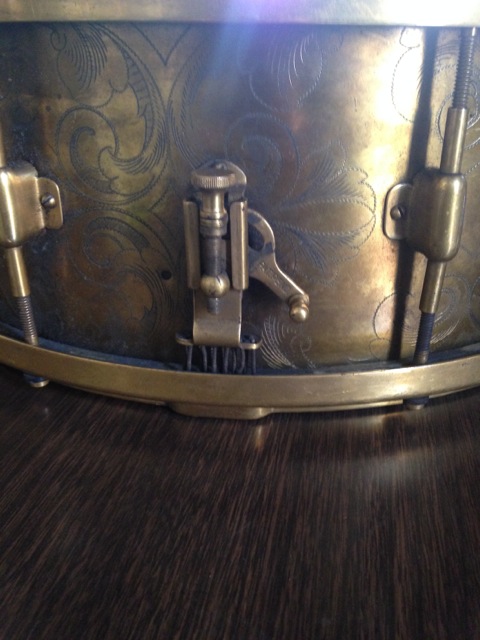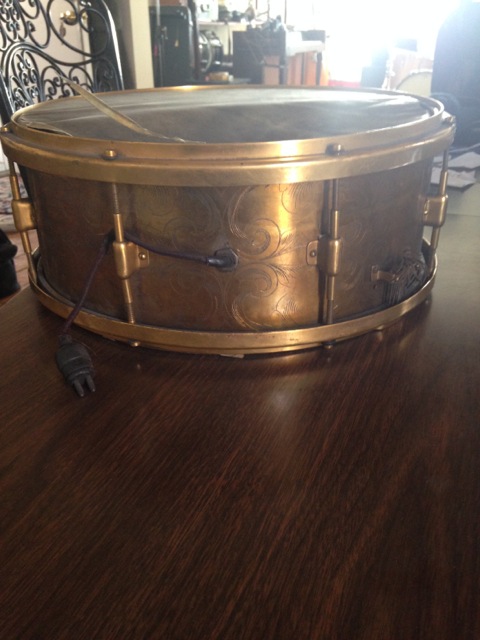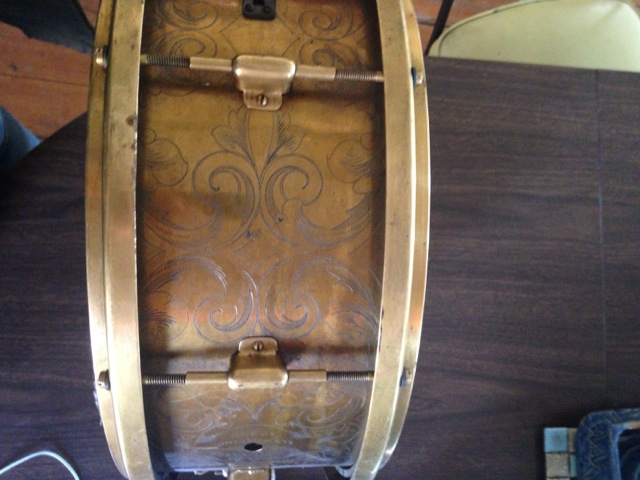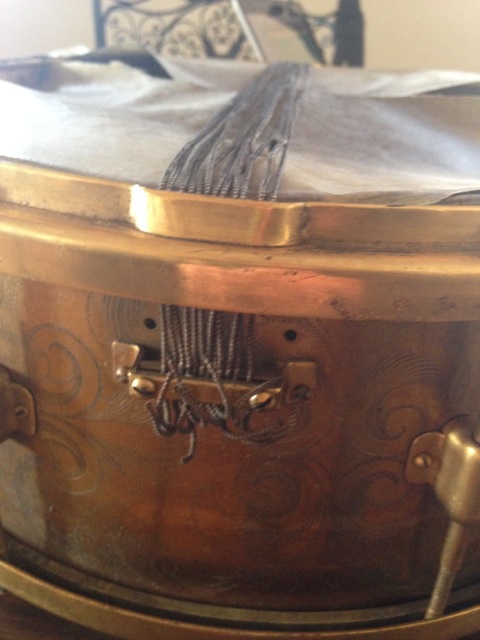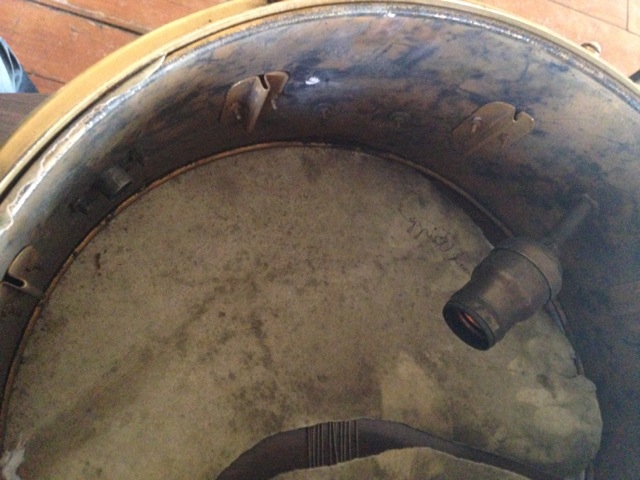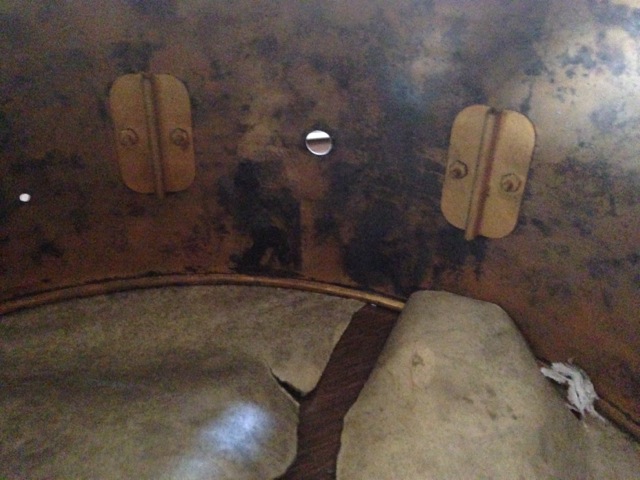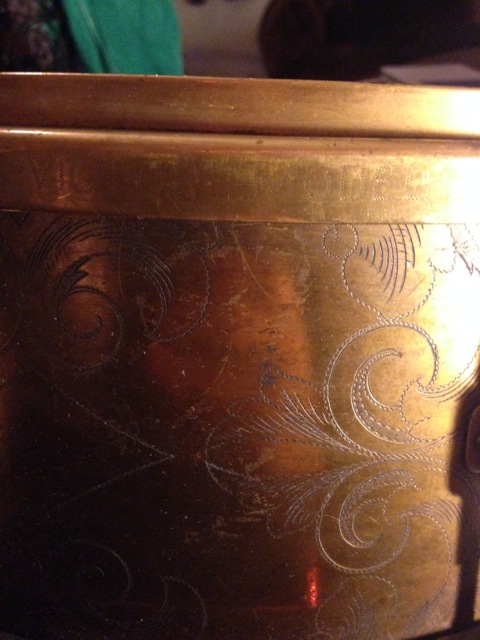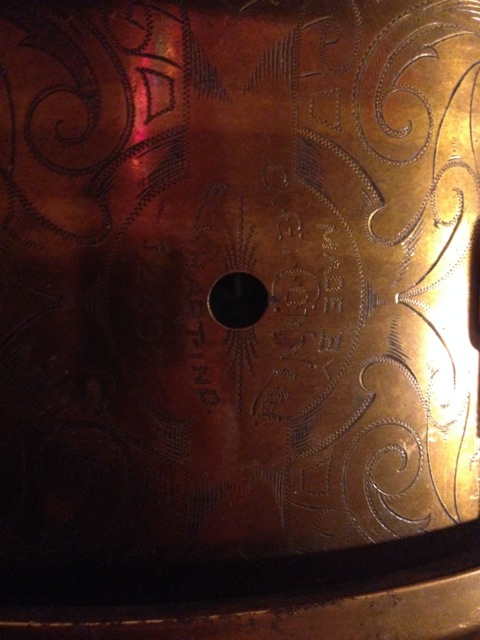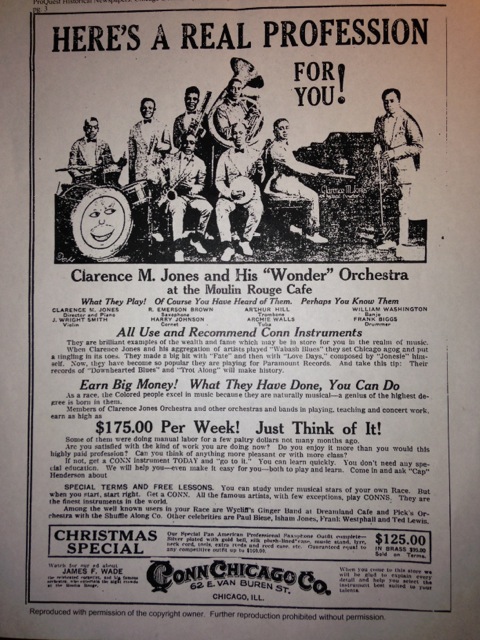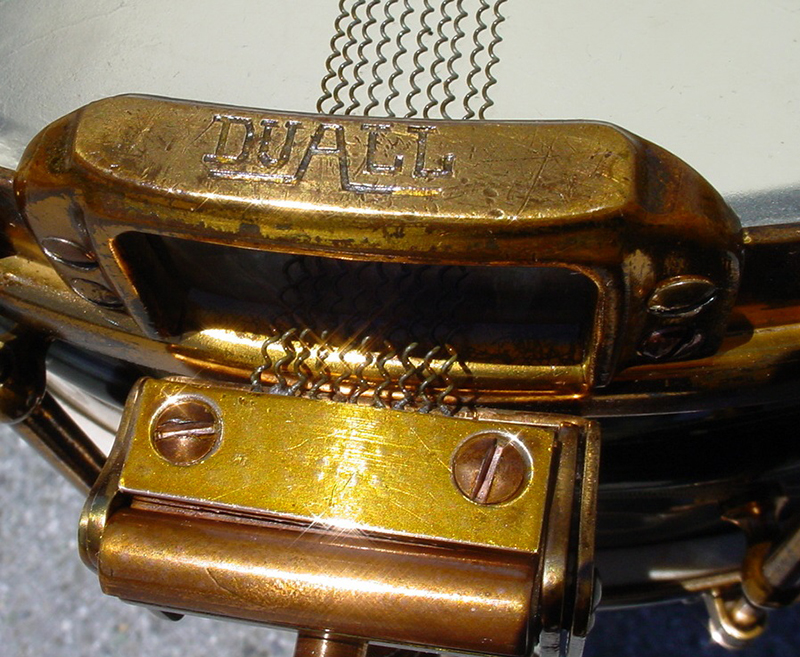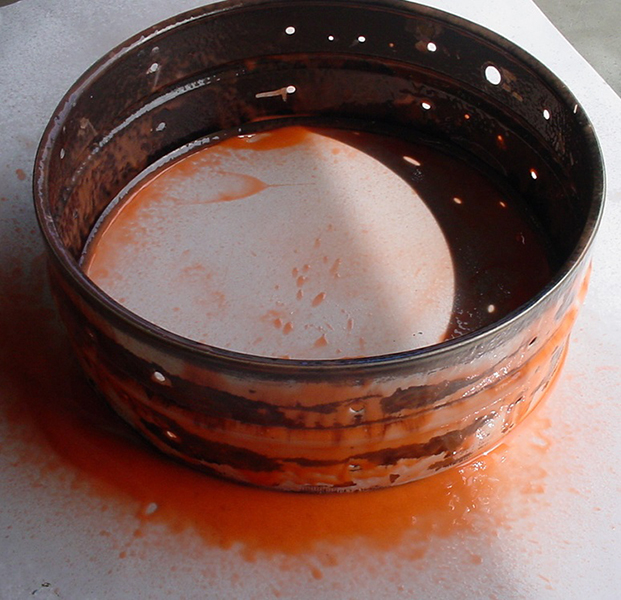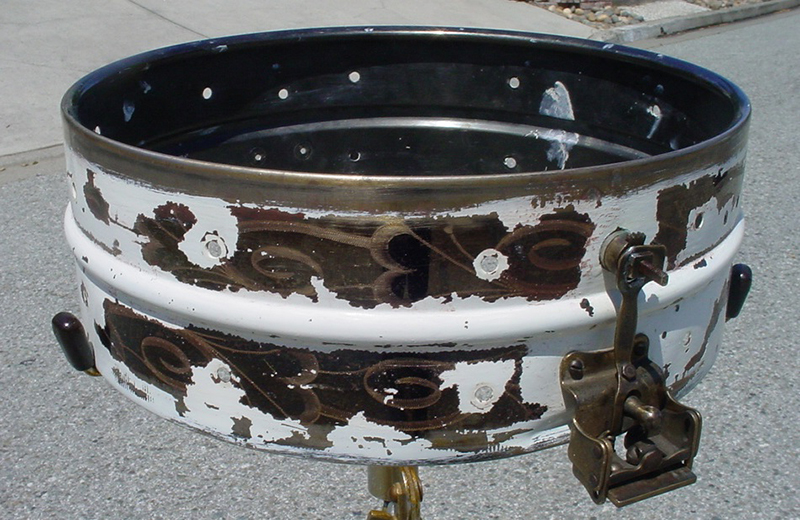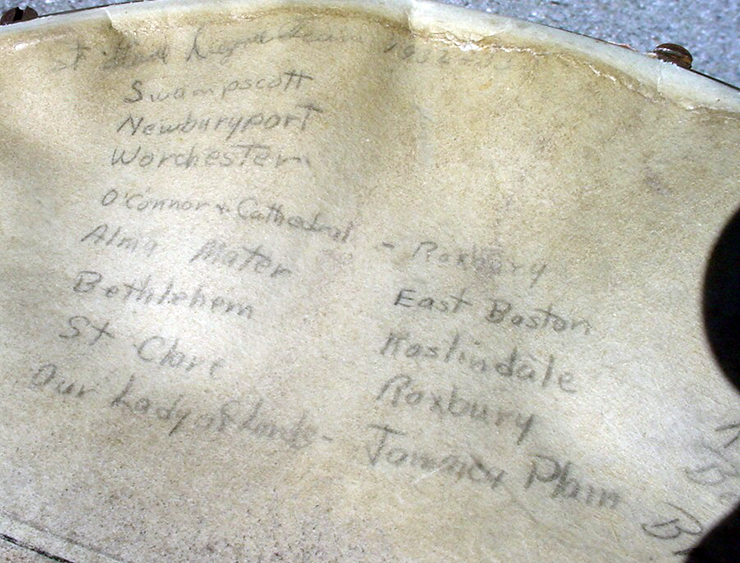I got this drum from Bun E. Carlos at the 2013 Chicago Vintage Drum Show. Bun E. Carlos had the only two known Leedy & Ludwig Zebra snare drums, a 4 x 14 Broadway New-Era and a 5 x 14 Broadway Standard. He sold me the 5 x 14 Broadway Standard. The drum was previously owned by Mark Cooper of Coopers Vintage Drums and a special thanks goes to Mark for the additional info on this drum. Bun E. also helped me to authenticate the Zebra finish by giving me a few photos of his Leedy & Ludwig “Salesman Sample” floor tom shell that shows the Zebra finish as one of the samples. Bun E. added this: "The wrap was available to the general public. Aside from your drum, and my 5 drums, I've seen only 2 other Zebra drums, a big bass drum and floor tom on EBay a few years back. Only 8 drums, rarer than an original Triumphal!!!!! Haha!!"...? I love Bun E.’s wry sense of humor.
Read moreChicago Drum Co. "American Classic" 6.5x14
Chicago Drum Company American Classic Series with a "Red, White and Blue" finish. The shell is a 5 ply 3/8" maple/poplar shell, with 30 degree w/roundover edges. It features solid maple steam bent reinforcing rings, chromed steel stick saver hoops, 20 strand Pure Sound wires, and a 3 point vintage throw off. This drum really sings - and is a fine work of art.
Did you know you can WIN THIS DRUM? All you have to do is buy an advanced ticket to the Nashville Drum Show. Advanced ticket holders will be entered into a drawing to win this $800 drum. You do not need to be present to win, and advanced tickets start at $15!
To buy your ticket and enter this raffle, click here.
1923 Conn Engraved Snare Drum
Hi All,
This is my first article on NSMD. I’m a drummer in Chicago and happened upon what turns out to be quite a cool drum.
Here’s the story: I was checking out a local vintage clothing/thrift shop in my neighborhood a few months ago. I saw this beat up looking old metal drum sitting on a corner shelf. At first I thought it was possibly an old antique toy drum for a child, but up close I saw that it was a Conn. I was more interested but was still thinking to myself if it was a Ludwig or something maybe I’d buy it (I didn’t know too much about Conns.) Then I noticed all the cool engravings including one that read “Frank Biggs 1923.”
So, I thought I better at least google Frank Biggs. It turns out Biggs was a popular jazz drummer in Chicago in the 1920s onward..He is credited as writing “That’s When I’ll Come Back To You” recorded by Louie Armstrong’s Hot Seven. There are some articles and announcements of him playing at different Chicago Jazz hotspots, etc... including a great ad for Conn from 1922 with his photo in it (maybe that’s the drum?)
So, the jazz buff in me wanted that drum just for the cool story behind it. It’s always cool to find out where an old instrument came from. I went right back and bought it for not a whole lot of money. My initial thoughts were to restore it, play it, and bring it back to life.
On to the drum itself, this past week I contacted Adrian Kirchler, Harry Canangy, and Mike Curotto. All of whom shared their expertise with helping me further identify this drum. Turns out it’s a custom made, custom engraved gold plated Conn Victor Model. A real “gem” as Adrian called it, a one of a kind. And while it’s not a Leedy, Ludwig or Slingerland, it’s really a neat piece with a cool connection to early Chicago jazz. Maybe not the best idea to take out on various gigs?
There’s a bulb fixture still in tact, all the lugs, rims, and shell are in great shape, actually. Also, Frank Biggs signed his name backwards on the inside of one of the heads presumably to illuminate his name through the bulb. It’s still completely legible.
There are some extra mounting holes by the strainer. There’s a higher end Ludwig strainer on the drum. The question Adrian had was whether or not Biggs ordered the drum with the better strainer or had the standard utility model removed and replaced it with the better Ludwig. An interesting thought…
Well, enough words, here are some pics:
Hope you all enjoy the drum. Feel free to email me if you have any more info, fun facts, etc... Jbatchko@hotmail.com. Again I’d like to thank Adrian, Harry, and Mike for their great help. And to Chicago pianist/sleuth Steven Heliotes for finding all the interesting info on Frank Biggs. And thanks, George.
Cheers, Jason
1932-34 Slingerland Duall "Radio"
Hi all,
Well, one of my “Holy Grail” snare drums was finally located and has entered the Curotto Collection. This is the only one that I have ever seen or heard of. The only reference that I am aware of is on page 4 of the 1934 Slingerland Drum Company catalog. The DUALL “RADIO” MODEL All Metal Drum was offered in a “5 x 14 or 6.5 x 14 shell depth, chromium or nickel plate finish, engraved black metal shell with chromium fittings or engraved black metal shell with Art Gold fittings”. The drum that I was fortunate to locate is catalog No. 43, "engraved black metal shell with Art Gold fittings."
This drum was found on a shelf in a middle school art classroom. The seller’s girlfriend alerted the seller who then made the deal with the school. The seller had originally contacted my good friend and fellow collector Steve Maxwell who then contacted me. Steve was gracious enough to allow me to contact the seller personally and the rest is history. So special thanks goes out to Steve Maxwell, to the seller Steven Gouty, to Mark Cooper (more on Mark later) and to Dave Brown of the UK who was cheering me on all the way through this deal. A final twist to this story is the fact that only three weeks earlier at the 2013 Chicago Vintage Show, Mark Cooper, Dave Brown and I were all wishing out loud how cool it would be if an engraved/Art Gold DUALL showed up at The Chicago Show!
1932-34 SLINGERLAND 5 x 14 ENGRAVED/ART GOLD DUALL “RADIO” MODEL
THE SHELL: So much for the good news...the shell was completely painted in white enamel, white lacquer or white something that took about two hours out of my life to strip. I was able to completely strip all of the white paint off of the shell and after a thorough cleaning and polishing I took the shell to Brian at Avenue Plating for a final lacquer clear coat. There were a few minor dents but nothing that I couldn’t take care of myself. The white paint actually protected the black nickel and the engraving. The shell is the lighter weight brass shell that Slingerland used on their 1928-32 nickel plated Artist Models and Artist Model Black Beauties, probably similar to the 1930s single piece shells that Ludwig & Ludwig used but definitely lighter than the 1919-29 L & L heavier two-piece brass shells.
I found a pair of calf heads that sat high enough on the shell so all of us can see the full engraving pattern.
THE HARDWARE: A lot going on here. The drum was missing 16 tension rods/washers, 16 collar hooks, the extension lever/thumbscrew, some assorted DUALL mechanism parts, the DUALL wires and the Harold Todd tone control. The existing double-flanged rims, 10 tube lugs and DUALL mechanism were pretty rough in that the Art Gold was almost all gone. I had a Todd tone control in my parts stash that I almost sold a few weeks earlier. Enter my good friend and fellow collector Mark Cooper of Cooper’s Vintage Drums. Mark was kind enough (I know I’ll pay for this someday) to sell me an intact Gold Sparkle/Art Gold DUALL Model that I was able to use as a “donor” drum for this important project. In order to make my drum function properly I had to do a little swapping out of the DUALL mechanisms. A few of these parts needed special attention so my machinist/welder Abe Abello of Weld-Tec was able to do the final tweaking and he was able to save the original parts. Abe is worth his weight in gold! The DUALL stamp is located in an unusual place at the bottom of one of the snare guards and the usual “manufacturer’s cartouche” markings on the snare guards are “6” and “66”. The Art Gold hardware from the "donor" drum needed a little cleaning and restoring but everything turned out great and all of the Art Gold hardware still looks age-appropriate.
SOME OBSERVATIONS:
- The engraving pattern on this DUALL Model is more ornate than the engraving pattern Slingerland used on their earlier Artist Model Black Beauties. This is in contrast to Ludwig & Ludwig’s more sparse 6 + 4 flower engraving pattern that they were using as they were winding down the production of their Black Beauty Models of the same era.
- It is interesting that Slingerland called this drum the “Radio” Model even before the Broadcaster and Radio King Models were introduced.
- The DUALL mechanism on this metal drum is different from the wood DUALLs that I own (and have seen) in that there is no internal connecting rod running across the diameter of the shell. The DUALL mechanism simply engages/disengages the wires from the lever side but not as much from the butt side. This has become a mystery for me (and some friends) as we have tried to figure out how the DUALL mechanism on this drum differs (works) from the wood shell DUALL Models. You can clearly see at the butt plate side that there is no upper linkage but only the lower external DUALL mechanism. The hole above the butt side mechanism does not line up with that mechanism so this tells me that it is the factory air hole which is in the exact same place as my nickel plated 10 lug Artist Model of the same era (see photo). What I need here is an example of a DUALL “RADIO” MODEL All Metal Drum so I can physically see what's going on. I am asking anyone out there that has this model to please contact me.
In the meantime, the mystery continues...
Enjoy! Mike Curotto
(editor's note - See Mark Cooper's new column in this issue)
Splitting Hairs
“A rose by any other name would smell as sweet”… a famous Shakespearean quote from Romeo and Juliet. What has that got to do with drums you ask? I know I am beginning to sound like a “One Note Samba". As noted in my last NSMD submission, I am no Ludwig expert BUT it occurs to me that a commonly used reference of “transition badge” is, in fact, a misnomer. The badge above on the left has the reigning title, but the one on the right smells sweeter to me.
A little history…The Ludwig & Ludwig Drum Company was founded in the spring of 1909 by brothers William F. and Theobald Ludwig, manufacturing a bass drum pedal. Crude pedals of the day were “…not powerful or fast enough for the fast rag-time tempos” and the new Ludwig creation became an immediate success. So much so that the brothers began spending more time manufacturing rather than playing drums. That is, until Theobald fell victim to the great Flu Epidemic in 1918 and died at a young age of 29. By demand, William F. took over and devoted 100% of his professional career to manufacturing. Ludwig & Ludwig became the world’s largest drum company in the 1920’s, surpassing Leedy Drums. World War I put a damper on all non-war related manufacturing, but Ludwig was awarded a substantial contract from the US Government for rope tensioned drums and the company continued. After the war, returning musicians were in-demand for theater orchestras and Ludwig’s success flourished.
From William F, Ludwig Sr.’s booklet, 75 Years A Drummer…My Life At The Drums:
“In 1929, as the well-remembered depression drew near, some of us became, perhaps unduly, concerned about the future. The Stock Market collapse choked business and we owed money on our new building (built in 1923). After considerable deliberation, it was decided that the best way for Ludwig & Ludwig to ride out the storm would be to merge with the G.C. Conn Co. of Elkhart, Indiana.”
The Conn Company was already cash-strapped from the purchase of the Leedy Drum Company earlier. Conn proposed a merger with Ludwig receiving $1,000,000 of preferred Conn Stock. Facing bankruptcy, Ludwig was forced to accept. Unfortunately, the Market crash devalued the option to $100,000. Ludwig, being the eternal optimist and being at odds with the Conn business model (which included not only another drum company but a full line of musical instruments) decided,
“In the year 1937…to start all over again in the drum manufacturing business and bought the 20,000 square foot factory building at 1728 N. Damen Ave. in Chicago…The new firm was named the Wm. F. Ludwig Drum Co.”
Conn was quick to notice and had their attorneys file for trademark infringement (Conn owned the Ludwig name). Ludwig Sr. was forced to change the company name to WFL Drum Company. Knowing the brand recognition of the Ludwig name, he wisely inscribed his logo badges to include “Wm. F. Ludwig, Founder”. Conn was enraged but Ludwig was totally within his right, a totally legal procedure."
Son Wm. F. Ludwig, Jr. joined the company one year later and albeit a slow start, the WFL Drum Company began to grow. World War II soon erupted but with some innovate designs to overcome the ensuing government metal restrictions together with Ludwig’s uncanny ability to secure government contracts, the WFL Drum Company received “the largest contract for field drums that had ever been placed with a single manufacturer.” Post war sales flourished with the war-weary population turning to music to relieve their depression. That coupled with the signing of Buddy Rich as an endorser, WFL, with Ludwig at the helm, became a major contender once again. Rich’s endorsement was not without pain though. WFL Jr. later recounted,
“My six most feared words were ‘Buddy Rich is on line two.'”
Still, the path was definitely silver lined, especially when Ludwig Sr. got the call of his dreams. Conn had a number of set backs including a 110 day strike of their labor force. In 1951, in an effort to consolidate their efforts they merged the Leedy and Ludwig & Ludwig names to offer the Leedy & Ludwig Drum Company. By 1955, lack of direction coupled with some design failures forced Conn to reconsider keeping drums in their instrument offering. The decision was made to sell the drum line…the Leedy name to Slingerland, the Ludwig name would go full circle, back to the Ludwig family. Ludwig Sr. continues,
“after exactly twenty-five years…I ‘owned’ my own name once more!”
That same year WFL offered a new catalogue with Buddy Rich proudly displayed on the cover and a WFL badge that still contained Wm. F. Ludwig, Founder at the bottom. The drums produced at this time however (with some exceptions) had badges that were stamped “WFL” at the top and “Ludwig Drum Co Chicago USA” at the bottom. The 1957 catalogue includes a WFL badge with this “Ludwig Drum Co. Chicago USA” inscription at the bottom. This continued until 1958 (I have seen 1958 date-stamped WFL drums with this badge). Then about 1959 the so-called “transition stamp” badge appeared with “Ludwig” at the top and “Drum Company” at the bottom. My question is, why is this the “transition badge” when the prior badge was emblazoned with “WFL” and Ludwig”? Isn’t that clearly the transition? When both names are included after the acquisition from Conn in 1955? I clearly remember in 1956 (see the April 2013 NSMD article “Taking the Driver’s Seat Of A Time Machine”) when the proprietor of Ballou’s Drum Shop in Dayton, Ohio, where my parents bought my set of WFL’s exclaimed, “Those drums are now being made by the Ludwig family.” It was a big deal at the time.
My take on it is, Ludwig was a great promoter. He also knew the value of brand recognition. After building the Ludwig name, only to have it taken away, he again built the WFL name (with the help of including his name as the founder). After seeing the Ludwig name denigrated by poor decisions and marketing by the Conn Company, he realized a quick name switch from WFL to Ludwig was definitely not in order. Though he was ecstatic to “own his own name once more!”, he wisely made the badge transition over a three year period that included both the WFL and Ludwig names. I know there are those that will fall back on the “they used whatever was available” theory. There is validity to that theory when applying it to parts like footboards and throw offs…sure, use up the remaining old logo parts but badges? This is the hallmark of the company. Ludwig’s emphatic reclaiming of his name, yet with proper marketing savvy, would contradict. Yet, almost all historical accounts mark the blue label badge as the first “Ludwig” badge after the reclaiming of the Ludwig name in 1955.
1936 L&S Catalog (Leedy & Strupe)
In October, 1929, an ailing U.G. Leedy sold Leedy Manufacturing to band instrument giant C.G. Conn Ltd. For the next 9 months, Leedy drum building was in a state of transition. In August of 1930, the Elkhart factory was up and running. In those intervening months, Conn sent in a supervisor, Ed Cortas, and many employees came and went. Leedy himself hoped that his 100 loyal employees would have jobs in Elkhart, but many of them did not or could not or, more probably would not, move. U.G. decided to create another company called General Products. Concerned that the Depression would not bring in drum sales, Leedy wanted General Products to make other products as well. But, they would make drums. The legend has become fact. He wanted to name the company Leedy & Sons. He had two sons—Eugene and Edwin, later called Hollis. Conn had just spent $900,000 in cash to buy the Leedy name, so there could be no use of that name outside the drums now made by Conn.
Best place to order essay online.
I have only seen one Strupe drum, but have seen publicity shots of others.
Mr. Leedy bought a former dairy building and started the process of turning it into a drum factory. Some of it was completed when he died in January, 1931. His widow gave this fledgling company the funds to complete the woodworking shop. Edwin joined as Secretary Treasurer. Eugene did not become involved.
Leedy and Sons became L&S and we now think that L&S also stood for Leedy & Strupe. One of the former key Leedy employees who did not leave Indianapolis, at that point, was Cecil Strupe, the engineer. He was named president of L&S. In the earliest days of production, there were also Strupe badged drums. It may have been an attempt to circumvent the Leedy name while promoting Strupe’s name since he was known to drummers thanks to frequent mention in the Leedy Topics.
Today’s catalog was made in 1936. It is the only L&S I have found. I have seen brochures, and I think this company deserves honorable mention in American Drum History. L&S drums were sold nationally by mail through Chicago Musical Instruments. Chicago Musical Instruments had formerly sold Ludwig & Ludwig drums through their catalog, but that deal soured when Conn bought Ludwig as well. So, the catalog sales company needed a new drum supplier. If you lived in Indianapolis, you could stop by the factory and buy from their showroom. Famed California jazz drummer Benny Barth, told me about that. An L&S snare was his first drum. L&S made drums, timpani, bells and other mallet instruments, but the products just always seemed a notch below Leedy in quality. You can see imperfections in the cast lugs, from the dies. The drum rods were hex headed, calling for a special key. I would say that like the Cecil Strupe designs for Leedy, we see the same kind of toggle crazy, and thin metal/weak spot strainer inventions on L&S snare drums.
The popular high end snare drum during the middle years was called the Dictator, which was probably not a wise choice during the Hitler and Mussolini years. I see example of L&S drums pretty regularly on eBay and they seem to come from all parts of the country, which may give proof to the scope of sales from Chicago.
The company was never a success, but it hung on and had an interesting ending. Strupe left the company and moved to Chicago where he went to work for WFL. Edwin Leedy sold the company to a music store owner who marketed the ready made products through his store. He changed the name to the Indiana Drum Company. At some point in the early 40s, Sears and Roebuck had a connection with Indiana Drum, using the name Drum Master and then may have bought the machinery and designs. Sears advertised that they had a factory in Chicago, and, in the one Sears Drum catalog I have seen (check out Drumarchive.com to see it), you can see L&S drums, no matter what they were called.
I am sure World War II ended Sears' need to have a drum manufacturing plant. After the war, they struck deals with Kent and Japanese manufacturers to have drum sets for sale in their catalogs.
But for 10 years, Leedy Indianapolis alums were building L&S "Drummers Equipment” and hoping for the best.
-Harry
The 1926-27 Liberty Snare Drum
Here’s a new one that just entered the collection (thank you Ebay). I always thought that Slingerland manufactured the parts for various drum companies including the Liberty Musical Instrument Corporation. But alas, I was mistaken. Check this out:
LIBERTY MUSICAL INSTRUMENT CORPORATION: Chicago, IL company founded in 1926 from the joining of two Boston firms--NOKES & NICOLAI, and JOSEPH PACHECO with the Liberty Rawhide Company, a major Chicago supplier of banjo and drum heads from 1920. Contemporary articles state that Liberty had purchased the "stock and good will" of the other two companies, and moved the stock in trade and equipment to new quarters in Chicago; each man was to have responsibility for his own end of the business, while John W. Placko, president of Liberty, was to supervise the manufacture of the drum and banjos heads. Within a year the new company had failed and was sold at auction, in August, 1927; since the factory and most of the machinery were new, there was great competition for the assets, which were finally purchased by Slingerland.
1926-27 5 x 14 LIBERTY SNARE DRUM Nothing earth-shattering here but I do like the history involved with this snare drum. I am not even sure what the model name is so any Liberty catalog photos will be welcomed. The shell is aluminum, the rims are steel, there are 8 double-tension lugs, 16 screw-type tension rods, calf heads top and bottom, 12 silk-wound snare wires and the flip-down strainer is pretty primitive . The Liberty badge is quite different than the Liberty badges that are on my other Liberty snare drums. Those badges are more like the brass oval badges that Ludwig & Ludwig used in the mid-1920s to the early 1930s. The batter head has some signatures from yesteryear and it looks like M. J. D’Arcy was possibly the original owner of this drum. That’s about it, feel free to weigh-in with any other information.
Enjoy! Mike Curotto

